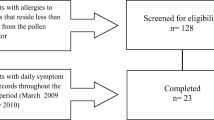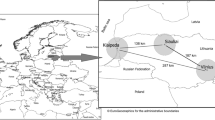Abstract
The air that we inhale contains simultaneously a multiple array of allergenic pollen. It is well known that such allergens cause allergic reactions in some 15 of the population of the Western World. However little is known about the quantitative aspect of this phenomenon. What is the lowest concentration of pollen that might trigger allergic responses? As people are exposed to heterogeneous and variable environments, clarification of the partial contribution of each of the major airborne pollen allergens and determination of its role in invoking allergy are of prime importance. Objectives: (1) Assessment of a possible correlation between the concentration of airborne pollen and incidence of allergy. (2) Estimation of the lowest average concentrations for various species of airborne pollen that elicit allergic symptoms when exceeded. (3) Determination of the extent of the variations in manifestation of allergy symptoms that can be explained by fluctuations in the concentration of individual species of airborne pollen. Methods: The study was conducted during 14 months with a rural population in Israel. The participants completed a detailed questionnaire and were skin prick tested with the common airborne allergens. The appearance of clinical symptoms, i.e. nasal, bronchial, ocular or dermal, were reported daily by the patients. Concentrations of the airborne pollen and spores were monitored in the center of activity of the residents during one day every week, using three ‘Rotorod’ pollen traps. The pollen grains were identified by light microscopy. Results: The pollen spectrum was divided into time-blocks presenting the main pollination periods of the investigated species. The correlation between the concentration of airborne pollen of the relevant species and the clinical symptoms of the patients was determined for each time block. The correlation differed for different clinical symptoms and for different pollen allergens. Highest correlation with airborne pollen counts was found for patients with nasal and bronchial symptoms. The onset of the clinical symptoms by sensitive patients started, in each of the relevant groups, once the weekly average concentration of the airborne pollen crossed a threshold level. Under the limitations of the present study, this level was estimated to be 2–4 pollen m−3 air for olive, 3–5 pollen m−3 air for grasses, 4–5 pollen m−3 air for Artemisia, 10–20 pollen m−3 air for pecan and 50–60 pollen m−3 air for cypress. Conclusions: Fluctuations in specific airborne pollen grains explained up to 2/3 of the variation in clinical allergy responses. Those were: 69 of the variation for cypress (March–April), 66 for the grasses (March–April), 49 for the pecan (May–June) and 62 for Artemisia (Autumn).
Similar content being viewed by others
References
Atkinson R.W. and Strachan D.P.: 2004, Role of outdoor aeroallergens in asthma exacerbations: Epidemiological evidence. Thorax 59, 277–278.
Carinanos P., Sanchez-Mesa J.A., Prieto-Baena J.C., Lopez A., Guerra F., Moreno C., Dominguez E. and Galan C.: 2002, Pollen Allergy related the area of residence in the city of Cordoba, South West Spain. J. Environ. Monitoring 4, 734–738.
Chapman J.A.: 2000, How relevant are pollen and mold spore counts to clinical practice?. Ann. Allergy, Asthma Immunol. 84, 467–468.
Charpin D.: 2000, Epidemiology of cypress allergy. Allergie et Immunol. 32, 83–85.
Charpin D., Huges B., Malea M., Sutra J.-P., Balansard G. and Vervolet D.: 1993, Seasonal allergic symptoms and their relation to pollen exposure in South-East France. Clin. Exp. Allergy 23, 435–439.
Charpin D. and Vervolet D.: 1996, Role of atmospheric pollutants in Asthma. Revue de Pneumologie Clinique 52, 70–78.
Charpin D. and Vervolet D.: 1997, New aero-allergens. Interaction between allergens and the environment. Bull. Acad. Nat. Med. 181, 1551–1561.
D’Amato G., Russo M., Liccardi G., Saggese M., Gentili M., Mistrello G., D’Amato M. and Falangiani P.: 1996, Comparison between outdoor and indoor airborne allergenic activity. Ann. Allergy; Asthma Immunol. 77, 147–152.
D’Amato G.: 2002, Outdoor air pollution, climate and allergic respiratory diseases: Evidence of a link. Clin. Expt. Allergy 32,1391.
Dolors Riera M., Teresa Cerda M. and Martin J.: 2002, A correlation study between airborne pollen and cases of pollinosis in humans. Aerobiologia 18, 169–173.
Filon F.L., Pizzulin Sauli M.L. and Rizzi Longo L.: 1998, Oleaceae in Trieste (NE Italy): Aerobiological and clinical data. Aerobiologia 14, 51–58.
Florido J.F., Delgado P.G., San Pedro B.S., Quiralte J., Arias de Saavedra J.M., Peralta V. and Valenzuela L.R.: 1999, High levels of Olea europaea pollen and relation with clinical findings. Int. Arch. Allergy Immmunol. 19, 133–137.
Frenz D.A.: 2001, Interpreting atmospheric pollen counts for use in clinical allergy: Allergic symptomology. Ann. Allergy, Asthma Immunol. 86, 150–157.
Garty B.Z., Kosman E., Ganor E., Berger V., Garty L., Weitzen T., Waisman Y., Mimouni M. and Waisel Y.: 1998, Emergency room visits of asthmatic children: relation to air pollution, weather and airborne allergens. Ann. Allergy 81, 563–570.
Geller-Bernstein C., Kennett R. and Waisel, Y.: 1996, Aerobiology in the prevention of allergy. In S.M. Tarik and J. Emberlin (eds), Clinical Applications of Aerobiology. Clinical Applications of Aerobiology. The UCB Institute of Allergy, pp. 69–75.
Geller-Bernstein C., Waisel Y. and Lahoz C.: 2000, Environment and sensitization to cypress in Israel. Allergie Immunol. 31, 92–93.
Goldberg A., Confino-Cohen R. and Waisel Y.: 1998, Allergic responses to pollen of ornamental plants: High incidence in the general atopic population and especially among flower growers. J Allergy Clin. Immunol. 102, 210–214.
Keynan N., Waisel Y., Shomer-Ilan A., Goren A. and Brenner S.: 1991a, Annual variations of airborne pollen in the Coastal Plain of Israel. Grana 30, 477–480.
Keynan N., Waisel Y., Shomer-Ilan A. and Finalt M.:1991b, Artemisia monosperma plants of the coastal plain of Israel as a source of allergens in Jerusalem. Harefuah 20, 716–718.
Kontou-Fili K., Borici-Mazi R. and Manikas A.: 2000, Cupressaceae: comparative pollen counts from the Athens metropolitan area 10 years apart. Allergie et Immunologie 31, 110–113.
Kosman E., Eshel A., Keynan N. and Waisel Y.: 1994, Clustering of allergenic pollen on the basis of skin symptoms of atopic patients by matrix analysis. Allergy 49, 502–507.
Kosman E., Eshel A., and Waisel Y.: 1997, The “Travelling Salesman Problem”: A new approach for identification of differences among pollen allergens. Int. Arch. Allergy Immunol. 112, 371–377.
Minero F.J.G., Candu P., Morales J. and Tomas C.: 1998, A study of non-arboreal pollen collected during ten consecutive years in the air of SW Spain. Effect of drought period on pollen spectrum. Grana 37, 367–373.
Negrini A.C., Voltolini S., Troise C. and Arobba D.: 1992, Comparison between Urticaceae (Parietaria) pollen count and hay fever symptoms: assessment of a “threshold value”. Aerobiologia 8, 325–329.
Rachmiel M., Verleger H., Waisel Y., Keynan N., Kivity S. and Katz Y.: 1996, The importance of the pecan tree pollen in allergic manifestations. Clin. Exp. Allergy 26, 323–329.
Siracusa A.: 2001, Epidemiology of Asthma and Rhinitis due to grass pollen allergy. Allergo J. 10, 82.
Siracusa A., Marabini A., Sensi L., Bacoccoli R., Ripandelli A., Anulli R. and Pettinari L.: 1997, Prevalence of Asthma and Rhinitis in Perugia, Itali. Monaldi Archives for chest disease 52, 434–439.
Siracusa A., Marabini A., Pace M.L., Tacconi C., Bussetti A. and Frenguelli G.: 2003, Asthma and rhinitis: Relationships with pollen concentration. Third European Symposium on Aerobiology (TESA) Worcester UK Abstracts, p. 64.
Subiza J.: 2001, How to interpret pollen counts. Allergol Immunol. Clin. 16, 59–65.
Thibaudon M.: 2003, Threshold of allergenic risk for the pollinic information in France. Third European Symposium on Aerobiology (TESA) Worcester UK Abstracts, p. 155.
Tobias A., Galan I., Banegas J.R. and Aranguez E.: 2003, Short term effects of airborne pollen concentrations on asthma epidemic. Thorax 58, 708–710.
Vieira F.A., Ferreira E.N. and Cruz A.A.: 1998, Grass allergy increases the risk of tree pollen sensitization: A warning to urban planners. J. Allergy Clin. Immunol. 102, 700–701.
Waisel Y., Keynan N., Geller-Bernstein C. and Dolev Z.: 1991, Urban pollution with allergenic pollen: Sources and cosequences. In: M.A. Ozturk, U. Erdem and G. Gork (eds), Urban Ecology. Ege University Press, Izmir, pp. 24–38.
Waisel, Y.: 2001, Threshold concentrations of pollen and spores: Roundtable discussion prologue. Allergo J. 10, 78–80.
Waisel Y., Meinis Z. and Geller-Bernstein C.: 2003, Pollen induced allergy: What is the partial contribution of individual species? Third European Symposium on Aerobiology (TESA) Worcester UK Abstracts, pp. 68–69.




